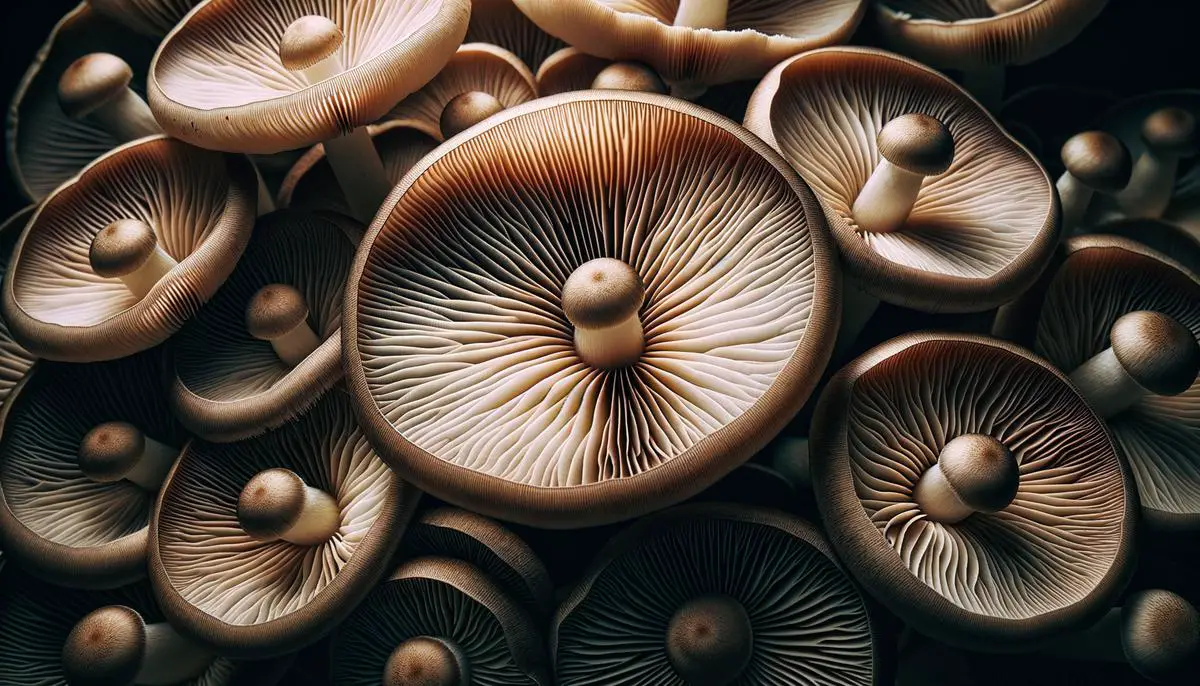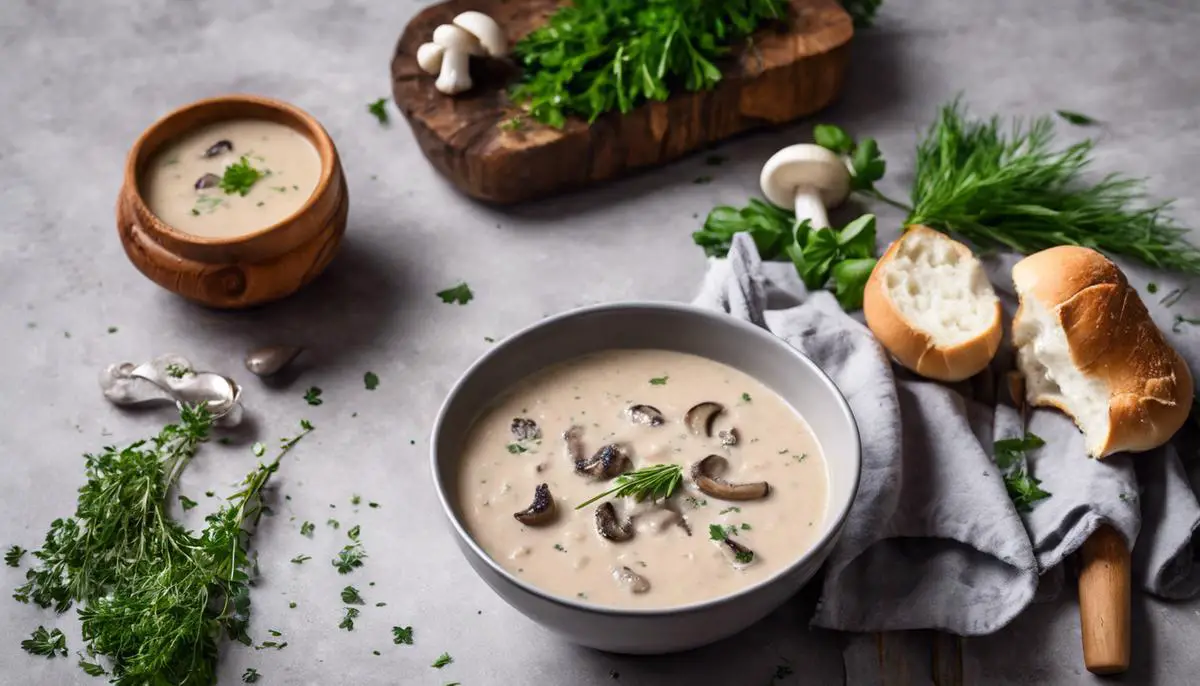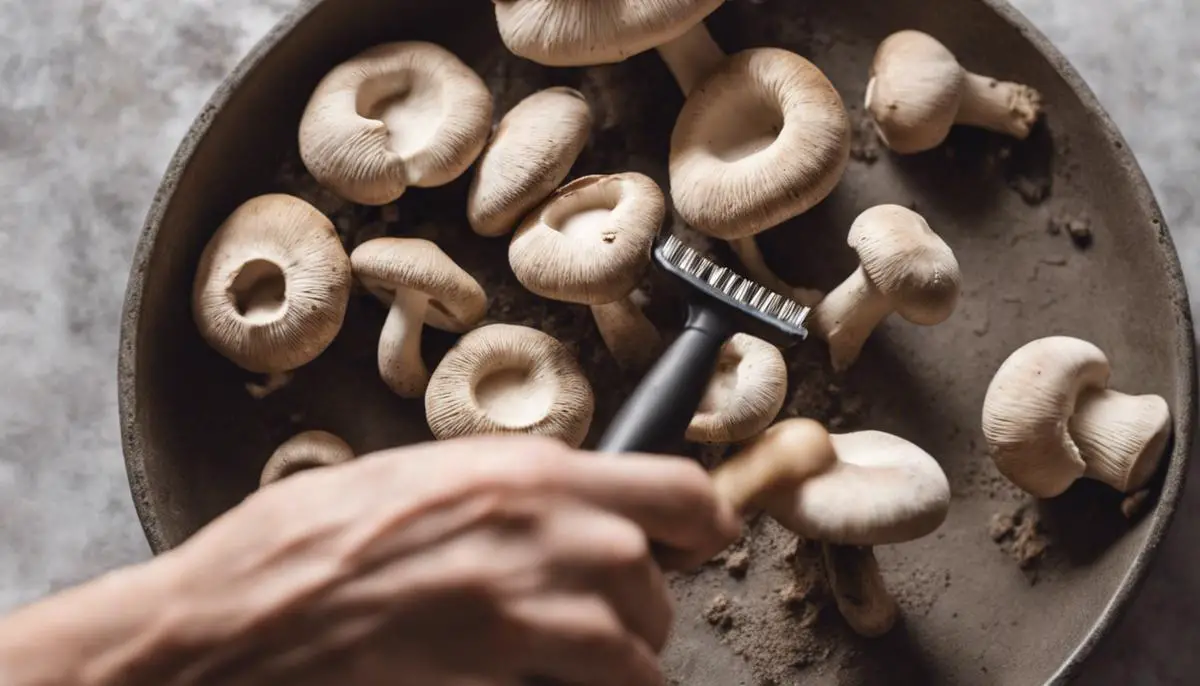
Cremini Identification
Cremini mushrooms stand out with their small size and smooth, rounded caps. Unlike the relatively larger portobellos, cremini mushrooms are more compact, making them perfect for a variety of dishes. The caps are roughly 1–2 inches in diameter, sitting snugly on short, neat stems. This size makes them versatile, ideal for sautéing whole or slicing up for your culinary creations.
Their color sets them apart from white mushrooms; cremini have an appealing earthy, tan to brown hue. This darker color matches their deeper, more robust flavor compared to their white counterparts. When shopping, if you spot mushrooms that strike a balance between white and portobello in both size and color—hearty yet not oversized, brown but soft in tone—you've likely found the cremini.
The texture of cremini mushroom caps is notably firmer and meatier than that of the more tender and somewhat moisture-filled white mushrooms. This denser texture not only adds a satisfying bite but also allows them to hold up well during cooking, whether they're being simmered in gravy or tossed into a fiery sauté pan.
Another tip for identifying top-quality creminis is to examine the underside of the mushroom cap. The veils covering their gills should ideally be partially closed. A closed veil indicates a younger, milder mushroom, while a slightly more open veil hints at a richer flavor profile, all the while ensuring you're still enjoying a cremini rather than crossing into mature portobello territory.
For those determined to choose the freshest creminis, give the caps and stems a gentle squeeze. They should feel solid and springy, not soft or slimy. Fresh cremini mushrooms will have a clean, mild scent—avoid any with a sour or off smell.
Remembering these identifiers—size, color, texture, and the state of the veil—will empower you to confidently navigate the mushroom section. With this knowledge, you're well on your way to enriching your dishes with the distinctive taste and texture of cremini mushrooms.

Culinary Uses
The culinary versatility of cremini mushrooms unveils a world of flavors and textures, ready to enhance an assortment of dishes that yearn for that earthy, robust quality only mushrooms can deliver. Whether incorporated within a velvety sauce, adding depth to a nourishing soup, or serving as a hearty meat substitute, creminis effortlessly adapt, showcasing their resilience across various culinary contexts.
Consider the harmonious combination of a richly simmered mushroom risotto. Here, cremini mushrooms absorb flavors while imparting their own, culminating in grains of rice accentuated with a medley of earthy tones, each spoonful a testament to cremini's absorbing capabilities. The slight resistance of well-cooked cremini pieces nestled among the creamy rice offers evidence of their integral role in elevating dishes to memorable dining experiences.
In the realm of soups, a creamy cremini mushroom soup can transform a dreary day into a comforting culinary experience. The inherent meatiness of cremini mushrooms provides a substantial foundation, allowing for layers of flavor to unfold with each simmer. Blended until smooth and combined with a touch of heavy cream, the presence of cremini mushrooms translates into a richly satisfying bowl, indulging the senses with its deep flavor profile.
For those seeking heartier or meat-free alternatives, cremini mushrooms emerge as a reliable option. Their substantial texture allows them to stand in effectively for meat, such as in vegetarian or vegan bolognese where they are diced and sautéed to perfection, absorbing the savory juices and spices of the sauce. Or, consider the innovative mushroom and chile tacos, wherein sautéed cremini mushrooms take center stage, harmonizing with spices and fresh herbs to create a filling as satisfying, if not more so, than traditional meat fillings.
Even beyond the confines of main courses, creminis graciously lend themselves to being impressive additions to breakfast scrambles, elegant toppings for bruschetta, or as dignified accompaniments to grilled steaks, each slice radiating with an earthy smokiness that hints at culinary perfection.
As we explore these countless uses of cremini mushrooms in our kitchens, we're not just cooking; we're telling stories hand in hand with these unassuming fungi. From their meaty texture during a sauté to their rich depth in broths and sauces, creminis don't just occupy space on our plates—they enrich our palates and expand our culinary adventures with every dish they grace. Encouraging such experimentation is not merely about presenting options; it's an invitation to discover the endless potential that cremini mushrooms offer, urging every home cook to consider them as versatile partners in the art of cooking.

Storage and Preparation
Embarking on the journey from purchase to plating with cremini mushrooms necessitates a brief pause at the stations of storage and preparation. Valued for their earthiness and versatility, these culinary champions deserve proper care to ensure they retain their freshness.
Upon bringing your cremini mushrooms home, a crucial first step is ensuring their longevity. Diverging from intuition, one does not simply toss these treasures into the refrigerator and hope for the best. Rather, thoughtful storage is the secret to prolonging their freshness.
- Keep the mushrooms in their original packaging if it allows breathability; otherwise, a paper bag will serve as an excellent choice, allowing them some needed air circulation.
- This simple switch promotes an environment where moisture—an enemy of mushrooms—is kept at bay, thus slowing the progression towards sogginess.
- Storing them properly in the central area of your refrigerator, away from strongly scented foods, ensures that your creminis remain unblemished by external flavors. Mushrooms are known for absorbing odors, and a cremini absorbing unintended essences could compete rather than complement in your culinary compositions.
Turning our attention to preparation, conventional wisdom may suggest washing fruits and vegetables, yet mushrooms—and creminis in particular—require a gentler approach. With their absorbent forms, these fungi are prone to becoming waterlogged, an issue that renders them less adept at browning in a hot pan.
When it comes time to clean your creminis, consider briefly introducing them to a cool water bath. A quick swish and a swift withdrawal, followed by an immediate pat down with a towel, suffices. This method minimizes water absorption and prepares them for cooking. For those wary of water's impact, a soft brush or a clean towel can remove any debris, a nod to the mushroom's ability to withstand gentler forms of cleaning.
As for tailoring your creminis to fit dish-specific needs, a knife becomes your tool of choice:
- The humble slice is most versatile, cutting the mushroom into flat pieces that integrate seamlessly into sauces and sautés.
- When aiming for a meatier presence, halving or quartering allows the cremini to assert its texture more prominently within stews and grills.
- And for those enchanted by the rustic elegance of mushrooms served whole, merely trimming the stems suffices, positioning them as notable figures within your culinary narrative.
In mastering the nuances of storage and preparation, the cremini mushroom transforms from a mere ingredient to a character within the story of each meal prepared. By taking the time to properly store and prepare these delightful mushrooms, we extend not only their shelf life but also enhance their potential to elevate our dishes. With these practices, creminis faithfully oscillate between roles of humble sustenance and gourmet highlight, ready to fulfill their destiny on the plates of discerning food lovers.

In the grand tapestry of culinary ingredients, cremini mushrooms stand out for their versatility and depth of flavor. By paying close attention to their selection and care, as outlined, one can elevate ordinary dishes into memorable culinary experiences. The key lies in recognizing the cremini's potential as not just an ingredient but as a character that enriches every meal it graces.
- Royse DJ, Baars J, Tan Q. Current Overview of Mushroom Production in the World. In: Cunha Zied D, Pardo-Giménez A, eds. Edible and Medicinal Mushrooms. Chichester, UK: John Wiley & Sons, Ltd; 2017:5-13.
- Feeney MJ, Miller AM, Roupas P. Mushrooms-Biologically Distinct and Nutritionally Unique: Exploring a "Third Food Kingdom". Nutr Today. 2014;49(6):301-307.
- Valverde ME, Hernández-Pérez T, Paredes-López O. Edible mushrooms: improving human health and promoting quality life. Int J Microbiol. 2015;2015:376387.



